|
Welcome to the Winter edition of Living on the Edge, the newsletter of the Coastal Wildlife Conservation Initiative! This is a quarterly newsletter to update Florida Fish and Wildlife Conservation Commission (FWC) staff, partners and members of the public interested in Florida’s coastal issues about current projects and other points of interest. Regular highlights will include featured projects related to coastal wildlife, interviews with our staff or partners, special seasonal considerations, news and events, and current funding opportunities. If you are interested in spreading the word about your project or someone who is doing a fantastic job in coastal conservation, please contact the CWCI Coordinator, Fara Ilami, at fara.ilami@myfwc.com.
The Coastal Wildlife Conservation Initiative is an FWC-led multi-agency strategy to address threats to coastal wildlife and habitats, while considering human interests and uses of Florida’s coastal areas. The goal is a statewide, cooperative process to protect coastal wildlife populations, conserve and manage coastal ecosystems, and achieve balance between conservation and opportunities for recreation, commercial activities and responsible development.

The Imperiled
Species Management Plan rule changes are now in effect, including changes
in listing status for many species. The Florida Fish and Wildlife Conservation
Commission (FWC) approved the groundbreaking plan in an effort to achieve
conservation success with dozens of imperiled species throughout the state. The
plan outlines the steps to conserve 57 species along with the broader vision of
restoring habitats essential to the long-term survival of multiple fish and
wildlife species. Read more…

In April 2011, one year after the Deepwater Horizon oil spill, BP agreed to provide up to $1 billion
toward early restoration projects in the Gulf of Mexico. Since then, the
Natural Resource Damage Assessment (NRDA) Trustees have approved five early
restoration plans, encompassing 65 projects at an estimated cost of $866 million.
One of these projects, Florida Artificial Reef Creation and
Restoration conducted
by the Florida Fish and Wildlife Conservation Commission (FWC), was
selected in 2014 as a Phase III early restoration project. It includes offshore
marine artificial reef construction in five northwest Florida counties,
Escambia, Santa Rosa, Okaloosa, Walton and Bay, and the City of Mexico Beach.
The goal of this project is to replace lost recreational
opportunities caused by the Deepwater
Horizon oil spill. Due to the months-long spill, large areas of the Gulf of
Mexico were closed to fishing, and extensive damage to marine and wildlife
habitats and fishing and tourism industries were reported. The addition of new
artificial reefs off the Gulf coast of northwest Florida will provide new
locations for anglers and divers to visit and offset some of the negative fishing
and tourism impacts caused by the spill.
An anticipated 3,000 prefabricated artificial reefs will be
deployed within 48 permitted areas located in state waters (within 9 nautical
miles from shore). The $11,463,587 project is one of the largest artificial
reef construction projects in the history of Florida’s artificial reef program
(annual funding rarely exceeds $700,000).
The reefs to be deployed consist of a combination of the following
five designs:

Small
Tetrahedron Reef: 6-8 ft. tall, 10-ton hollow concrete walled structure
with three or more sides. This structure is the most common artificial reef
structure in the region.
|
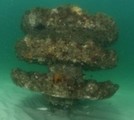
Concrete
Disk Reef: 8 ft. tall, three or more rock or shell embedded concrete layers
mounted on a piling. These particular reefs will be deployed within 500 ft.
from shore making them easily accessible. An underwater camera was
recently installed at a similar site offshore of Navarre Beach.
Photo
credit: Carol Cox
|
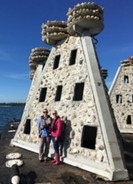
Large
Tetrahedron Reef: 18 ft. tall, 18-ton larger version of the original small
tetrahedron described above. These reefs are especially attractive to pelagic
species of fish such as amberjack.
|

Ledge and Disk
Reef: 6-8 ft. tall, 4-ton concrete structure with a vertical disk reef and
at least one side almost entirely open. This structure is especially attractive
to different species of grouper.
|
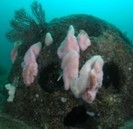
Large Dome Reef:
6-8 ft. tall, 7-ton concrete dome shaped structures with multiple small holes
throughout the structure.
Photo credit:
Carol Cox
|
The City of Mexico Beach deployed the first 301 artificial
reef modules as part of this project last year and will deploy an additional
200 modules through spring of 2017. These modules are deployed by a marine
contractor using a large barge and crane. The crane carefully lowers each
module to the bottom of the ocean floor to avoid breakage and ensure precise
placement in a specific orientation around existing structures.
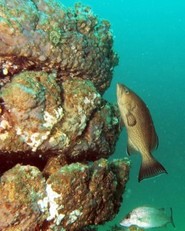
Following the successful deployment of all the artificial
reef modules, extensive monitoring will be conducted to track the people using
these reefs, the condition of the reefs and
the species inhabiting the structures. It is expected that in a short
amount of time they will be covered with encrusting invertebrates and teeming
with a number of different reef fish species including red snapper, amberjack
and grouper. These additional reef locations will provide generations of
anglers and divers with increased fishing and wildlife viewing opportunities
off the coast of northwest Florida. Photo credit: Carol Cox
For more information about the FWC’s artificial
reef program and the NRDA
project, visit MyFWC.com/Conservation and click on “Saltwater” and
“Artificial Reefs.” For more information
about the Gulf Spill Restoration program across the northern Gulf of Mexico,
visit gulfspillrestoration.noaa.gov.
Back to Top
|
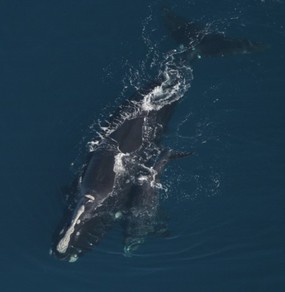
It’s that time of year when a trip to the beaches along Florida’s
east coast may result in a mom and calf North
Atlantic right whale (Eubalaena
glacialis) sighting. From November 15 to April 15, pregnant females migrate
southward along the coast from their feeding grounds in the northeast U.S to
the calm, warm waters off the Georgia and Florida coasts to give birth. These
calving grounds for the North Atlantic right whale were designated as right
whale critical habitat in 1994 by the National Marine Fisheries Service (NMFS).
Protecting whales at this critical life stage is paramount, especially as mothers
and calves travel together. The North Atlantic right whale is one of the most
endangered large whales in the world, with about 500 individuals remaining
today.
North Atlantic right whale migration routes hug the coast,
putting them in close contact with various human activities. They regularly
traverse shipping lanes and populated areas with heavy vessel traffic, and
unfortunately right whales are difficult to spot while boating. Their lack of a
dorsal fin, combined with their dark coloring, slow moving nature and time
spent near or at the surface, puts them at a great risk of vessel strikes. Several measures are in
place to alert and educate large ships about key right whale habitats,
including recommended shipping lanes and areas to be avoided, Seasonal
Management Areas (SMA) and a Mandatory Ship Reporting (MSR) system.
Boaters can look for education signs at boat ramps and marinas and learn how to
recognize and report right whale sightings .
Right whales’ habitat also overlaps with commercial
fisheries areas, thereby increasing whales’ chances of entanglement. Rope and
netting from fishing gear can cause injuries, infection, starvation and death.
Resting right whales are generally unaware of the dangers around them. Over 80
percent of the whale population exhibits scars from previous entanglements, and
these fisheries interactions can have long term impacts on the health and
calving rates of the whales. As members of the Atlantic Large Whale Disentanglement
Network, biologists in Florida and Georgia have received specialized training on
how to respond to entangled whales. If an entangled or dead animal is sighted,
immediately notify the U.S. Coast Guard on VHF CH. 16.
FWC researchers conduct aerial and vessel surveys off the
east coast of Florida and Georgia during calving season in collaboration with
NOAA Fisheries, the Georgia Department of Natural Resources and the Sea to
Shore Alliance. Photographs from these surveys are used to identify individual
right whales, monitor calving, habitat use and trends in health and scarring,
and to develop and evaluate recovery strategies. Some interesting life history
facts that have been observed in the surveys: females do not eat during calving
season and therefore need to conserve energy; healthy right whales produce one
offspring every 3 to 5 years; and these whales are capable of living more than
100 years. A sighting network using volunteers is also in place along Florida’s
east coast. It utilizes right whale reports by citizens and relays time-sensitive
information to biologists in the area.
When a right whale is sighted, it is important to report the
information as quickly as possible to 1-877-WHALE HELP (a NOAA sighting
hotline). Be prepared to provide the time and location of your sighting as well
as a description of the animal. Florida’s waters are home to several species of
large whales, so species identification is key. Below are identifying
characteristics for North Atlantic right whales:
- Callosities (large, white bumps)
- V-shaped blow
- Deeply notched tail with smooth trailing edge
- Broad, flat back with no dorsal fin
- Paddle-shaped flippers
- Up to 55 ft. long, up to 70 tons
- Black coloration
Back to Top
|
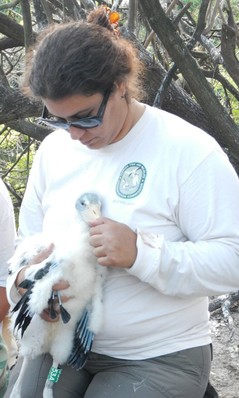
Carol is a former team member of the CWCI but has recently moved to a different position within the FWC. Her hard work on Critical Wildlife Areas is greatly appreciated.
-
What is your title? Currently Conservation Biologist. Formerly Critical Wildlife Area Coordinator and Assistant Regional Biologist.
-
What organization do you work for? Florida Fish and Wildlife Conservation Commission
-
What type of work do you do? I am currently responsible for implementing conservation plans for focal species on the agency’s Wildlife Management Areas in the South Region. Focal species include listed species, indicator species, keystone species or species that are otherwise locally important in the area. As the Assistant Regional Biologist, I performed similar tasks but on unmanaged lands. I also helped monitor and manage Critical Wildlife Areas in the region. As Critical Wildlife Area Coordinator, I worked with partners and stakeholders to establish new CWAs, ensured consistency in monitoring and management across the state and acquired funding to improve the program.
-
What project(s) have you recently been working on? Much of the past year, I worked on an unprecedented Critical Wildlife Area initiative. In November 2016, the Commission designated 13 new CWAs and modified 5 existing CWAs. After hearing an update about Bird Island CWA in April 2016, the chairman asked staff to find other areas across the state that needed protection from disturbance. Given other job duties, the process to establish a CWA typically takes about a year – from developing a proposal, summarizing data on wildlife use and disturbance, weighing alternatives, gathering public input, acquiring landowner concurrence to bringing the final proposal for approval. In this case, we were working on 19 proposals in about half the time. In the end, we were unable to get landowner concurrence for one site, but it was incredibly gratifying that all other staff proposals were approved.
-
How does your work relate to the CWCI? CWAs are a priority issue for CWCI since the majority of CWAs are coastal, protecting beach-nesting birds and wading birds from disturbance. Many of CWCI’s other priorities also overlap, such as vegetation management, dogs on beaches, and posting in navigable waterways. All of these issues are important components in the conservation of coastal wildlife. The only difference is that an area that has been designated a CWA has a legally enforceable boundary.
-
How long have you been working in the coastal environment, and what are some lessons you have learned? My work along the coast began 10 years ago doing sea turtle nest surveys. I then took a job that moved me to the center of the state, along the Lake Wales Ridge, before joining FWC in 2012. My work along the coast has been mostly bird-focused, but I’ve also been able to do surveys for beach mice, diamondback terrapins, and several species unique to the Keys. I have learned that coastal environments are far from static, and this makes them incredibly resilient. If given the opportunity to recover, they will.
-
What do you think is the greatest threat to coastal ecosystems, and what action(s) should be undertaken to address it? I think coastal development is the greatest threat. New development results in habitat loss. As sea levels rise, coastal armoring will likely increase to protect the infrastructure. Beaches and their associated wildlife will not be able to retreat naturally. Unfortunately, I’m afraid the future will be decided by the economics of building beaches and seawalls, rather than maintaining functioning ecosystems.
-
What is your favorite coastal animal, and why? I never had a favorite animal, coastal or otherwise. I find them all fascinating. I just can’t stand roaches, and the ocean may be the only place I’m safe from them.
-
Do you have a message you would like to share with readers of this newsletter? Sometimes I feel like humans have already done so much damage to this planet, and the prevailing paradigm won’t change, so what’s the point? But I wouldn’t have wanted a career in conservation if there wasn’t a sliver of hope that we can make a difference. Aldo Leopold, considered the father of conservation in this country, once wrote, “That the situation is hopeless should not prevent us from doing our best.”
Back to Top
|
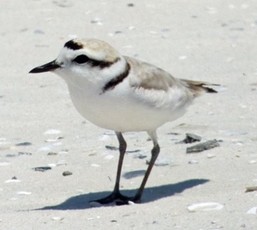
This winter’s Critter of the Quarter is the snowy plover (Charadrius nivosus), a small, quiet and
charming shorebird that resides and nests on beaches, barrier and spoil
islands, shorelines, sand bars and flats, and alkaline flats and lakes
throughout the Gulf Coast, parts of the Pacific Coast and western US interior,
throughout the Caribbean, and throughout portions of Central and South America.
In Florida, the snowy plover is a year-round resident (unlike Florida’s other
“snow birds”), with some populations migrating from breeding grounds in the
panhandle to the southwestern coast during the fall and winter months. The
snowy plover can reach a length of 6.7 inches, with a wingspan of up to 13.4
inches, and weigh up to 2 ounces. The snowy plover has a short, thin black bill
and grey legs. The upper body varies in color from greyish to light-brown with
a white belly, dark patches on sides of neck and behind the eyes, and a
distinctive black band across the forehead. In females and nonbreeding
juveniles, the characteristic black markings are browner in color.
In Florida, snowy plovers nest primarily on open sandy beaches
along the Gulf Coast between February and August. Nesting has not been
documented on the Atlantic Coast, but several nests have been found on inland
mining operations. During courtship, the males will make several practice
scrapes. The female will choose one of
these in which to lay her eggs. Sometimes the nest scrapes are lined with bits
of shell, pebbles or other beach debris and are well camouflaged to avoid
detection by predators and people. On average, each clutch consists of three
buff-colored eggs, lightly to moderately covered with dark, small spots. The
eggs are incubated and protected by both parents for 28-35 days. Snowy plover
chicks are precocial, which means within hours of hatching, the chicks are able
to leave the nest and feed on their own. However, both parents continue to
protect the chicks until they fledge approximately 30 days later. Snowy plovers
will commonly have 2-3 clutches per season, particularly if the first nest
fails.
The snowy plover is state-designated as Threatened in Florida and is federally protected under the
Migratory Bird Treaty Act. It is also included in Florida’s Imperiled
Species Management Plan. Snowy plover
populations in Florida are declining rapidly, mostly due to habitat loss from
coastal development, human-related disturbance, predation, washover from
storms, and sea level rise. In order to protect current populations and habitat
and help increase nesting success and chick survival, nesting areas throughout
the Gulf Coast of Florida are delineated with symbolic fencing and signage to
make beachgoers aware of the birds, nests and chicks. Nests and chicks are
difficult to see, as they blend in with the beach environment. Adult birds that
are flushed off the nest will call out and feign injury through a broken-wing
display. If this is observed, stop in place and walk slowly away, keeping eyes
on the ground for any nests or chicks which may freeze in place in an attempt
to hide.
For more information on the snowy plover and other beach-nesting
shorebirds and seabirds, and to discover volunteer opportunities to help
protect these important birds, please visit the Florida Shorebird Alliance.
Back to Top
|
NOAA Gulf of Mexico Coast Conservation Corps Funding Program — NOAA is seeking
applications from non-federal partners that will recruit, train, and employ
workers to work on habitat restoration projects and develop skills in support
of long-term Gulf coast restoration. The goal of the program is to provide
labor support to projects listed on the RESTORE Act Funded Priorities Lists,
projects funded through Deepwater Horizon oil spill settlements, and other
funded federal or state projects. The deadline is March 2, 2017.
NOAA FY 2017 Coastal Resilience Grants Program —
Proposed projects should build resilience in U.S. coastal communities,
economies, and ecosystems. The program intends to reduce risk from extreme weather
events and climate-related hazards. The deadline is March 15, 2017.
NFWF/Wells Fargo Resilient
Communities Program — The program will help communities prepare for
future impacts associated with sea level rise, water quantity and quality and
forest conservation. Special consideration is given to projects that help
bridge rural and urban community resilience needs with focus on the
interconnectedness of natural systems and community well-being. Pre-proposals
are due March 30, 2017.
NRCS Regional Conservation Partnership Program
— RCPP will make awards to locally driven, public-private partnerships that
improve the nation’s water quality, combat drought, enhance soil health,
support wildlife habitat and protect agricultural viability. The deadline is April 21, 2017.
Conservation Alliance — Seeks to protect threatened wild
places throughout North America for their habitat and recreational values. Accepts
grant applications from non-profit organizations with a focus on protection of
a specific wild land or waterway, engaging grassroots citizen action in support
of the conservation effort, and demonstrating a clear recreational benefit.
Organizations must be nominated before applying for grant requests. Nominations
are due by May 1, 2017 and proposals
are due June 1, 2017.
Fish and Wildlife Service
National Coastal Wetlands Conservation
Grants — Awards are to protect, restore and enhance coastal wetland
ecosystems and associated uplands. The grants are funded through the Sport Fish
Restoration and Boating Trust Fund, which is supported by excise taxes on
fishing equipment and motorboat fuel. Search grants.gov for F17AS00108. The
deadline is June 30, 2017.
Northrup Grumman — Supports
communities, projects and organizations, particularly where its employees live
and work, with financial, in-kind and volunteer resources. Grants are awarded
to accredited schools and 501(c)(3) nonprofit organizations for projects
focused on education and the environment, among others. Requests for funding
will be accepted beginning February 1, 2017 through June 30, 2017.
Rockefeller Family Fund — Grant
making currently has an environment program focus on the challenges of climate
change with an emphasis on public education. Letters of inquiry (LOI) may be
submitted at any time.
Surdna Foundation Grantmaking — Grant making to nonprofit
organizations in the priority areas of Sustainable Environments, Strong Local
Economies, and Thriving Cultures. Letters of inquiry (LOI) may be submitted at
any time.
Waitt Foundation Rapid Ocean Conservation
(ROC) Grants — This opportunity provides small grants with a quick
turnaround time for solutions to emerging conservation issues. The funding
cycle is open to new applications. Proposals are reviewed monthly on a rolling
basis, although some application take additional time to evaluate.
Wells Fargo Environmental Grant Program
— Environmental grant program focuses on addressing local environmental
priorities in communities and providing support that fosters innovation to help
accelerate a “green” economy. One letter of inquiry per year per organization
is accepted.
Back to Top
|